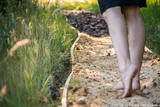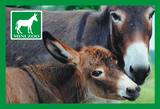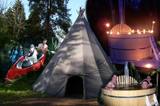| Nr | Name | Beschreibung |
|---|---|---|
|
Befindet sich nahe der Mittelschule von Rūjiena. Die vom Bildhauer Kārļis Zemdega errichtete Skulptur „Madonna Orans” wurde 1936 zum Andenken an die ertrunkene Lehrerin der Gemeindeschule Jūlija Skujiņa (24 Jahre alt) aufgestellt. Es gibt verschiedene Legenden über die Anlässe des Todes. Eine der Legenden ist mit einer unglücklichen Liebe zum Pastor Roberts Slokenbergs verbunden. |
||
|
Ein ehemaliges Fischerdorf am Ufer des Kurischen Haffs. Hierher sind die Bewohner der Dörfern umgezogen, deren Dörfe unter dem Sand der Wanderdünen begraben wurden. Holzbebauung des 19 – 20 Jh. |
||
|
Am Ufer der Venta erhebt sich eine wahre Perle der Holzarchitektur - die mit romantischen Geschichten und Legenden umwobene und unlängst erneuerte „Villa Bangert“. Man erzählt sich, dass ein gewisser Kapitän Bangert dieses Gebäude seiner Braut in Paris gekauft habe. Seit 1940 befindet sich in diesem Haus das Heimatmuseum der Stadt Kuldiga. In dem Museum hat man nach der Rekonstruktion der Räume die einzigartigen Wandmalereien und verschiedene andere Details im Interieur wiederhergestellt und somit eine Exposition – die Wohnung der Familie Bangert - geschaffen, die uns ein Bild davon gibt, wie eine wohlhabende kuldigaer Familie zu Beginn der 20er Jahre gelebt hat. Ausserdem kann man hier auch die Kollektion des Spielkarten- Sammlers Jāņis Mētra sehen. |
||
|
The tree is in the middle of an untended field. Despite many dead branches and the messy surroundings, the tree is beautiful and well visible from the road. It is the third thickest tree in the Baltic States.
|
||
|
Saimniecība audzē dažādus dārzeņus, lapu salātus, gurķus, dilles, ķiplokus, brokoļus, ziedkāpostus, sīpolus, ķirbjus, bietes utml. Vasarā un rudenī pieejamas avenes. Pārdošanā svaigi dārzeņi un augļi. |
||
|
Auf dem Barfußweg im Agrotourismushof Survilai in Šveicarija im Kreis Jonava kann man die Natur mit allen 5 Sinnen erfassen! Der Belag ist ausgesprochen abwechslungsreich: Kienzapfen, Moor, Torf, Lehm, Kies, abgeschliffene Glassplitter, Kiefernnadeln, Stroh, Hindernisstrecken und vieles andere. Der Pfad ist über einen Kilometer lang, sodass Sie die vielfältigsten, gänzlich unerwarteten Empfindungen wahrnehmen können, zusammen mit positiven Emotionen und einem Energieschwall. |
||
|
was built between 1930 and 1947. On both sides of the altar are sculptures of angels that date back to the late 17th century and were sculpted in Subate. They are the only elements of this kind in the Baroque decorative sculpture in churches in Kurzeme. It may be that the figure of the Saviour on the cross with a sleeping lamb at his feet was produced by the same artists. No one knows how the artworks arrived in Subate. The organ with its wooden pipes was manufactured by Juris Bokums. During the season, the interior of the church can be toured, and if you contact the church in advance, you can arrange for organ music performances. |
||
|
Dabiskā zemesragā starp Lielo un Mazo Ludzas ezeru 14. gs. beigās slejās seno latgaļu koka pils, kuras vietā Livonijas ordenis uzcēla Latgales varenāko mūra pili. Tā bija iespaidīga trīsstāvu celtne kvadrāta formā ar sešiem torņiem, trīs vārtiem un divām priekšpilīm. Pēc krievu iebrukuma Latgalē 1481. g., Ludzas pili atjaunoja 1525. g. 1654. g. to atkal izposta Krievijas cara Alekseja Mihailoviča karaspēks. Jau 18. gs. no pils bija palikušas tikai drupas, kas arī mūsdienās ir ļoti iespaidīgas un ainaviskas (ar skatu uz Lielo Ludzas ezeru un baznīcu torņiem). |
||
|
Im bäuerlichen Betrieb am rechten Uferbogen des Flusses Venta werden Ziegen gezüchtet und Käse hergestellt. Der Betrieb empfängt die Besucher und bietet Verkostung und Erwerb von Produkten an. Annahme von Bestellungen. |
||
|
Ķurmrags is one of the most distinct capes along the Vidzeme shore of the
|
||
|
Bed & breakfast "Upes", in the centre of Livonian village Pitrags. Natural toilet. Local products. Lunch boxes, transfer service on request. |
||
|
Bis 1724 gehörte das Gut damals als Vorwerk Cecina der Familie Hylzen. Nachdem die Tochter Jadvyga Jan Szadurski geheiratet hatte erscheint das Gut 1774 in Dokumenten unter dem Namen Malnava. Weiterhin gab es noch mehrere Besitzerwechsel. Das Hauptgebäude des Gutes ist im Stil des Klassizismus errichtet, teilweise mit barocken Zügen. Auf einer Seite des Gutshofes befindet sich ein Speicher, das Herrenhaus befindet sich an der Stirnseite des Hofes. Zum Zeitpunkt der Bodenreform in Lettland 1920 war das Gut Malnava mit 12.400 Heltar eines der größten Güter in Lettland. Das Gutshaus wurde im 2. Weltkrieg zerstört, zwar wurde es wiederaufgebaut, aber die Inneneinrichtung ist nicht erhalten. Von den Wirtschaftsgebäuden ist der aus der ersten Hälfte des 19. Jh. stammende klassizistische Speicher erhalten sowie einige weitere Gebäude. Das Gutsensemble wird von einem Park ergänzt, in dem jetzt immer noch einige fremdländische Bäume und Sträucher wachsen, z.B. ein Amur-Korkbaum. Es gibt auch zwei Stahlbetonbunker, wo Hitler Mal kurze Zeit anwesend war. Auf dem Territorium befindet sich auch die Schnapsbrennerei der Marke „Latgales šmakovka“, wo Besucher sich mit der Herstellung von Hochprozentigem von frühesten Zeiten bis heute bekannt machen können. |
||
|
The rest complex is situated on the shore of the man-made water reservoir, and there are two saunas on the territory – the Big sauna and the Small sauna. In the building of the Big sauna it is possible to organise different events for as many as 40 people, and in summertime – till 60 people. In the Small sauna – up to 20 people. Apart from the saunas, there are offered 20 different picnic places with tables, places for grills and tents, volleyball playgrounds, boats and water-bicycles for rent. |
||
|
The Liv Coastline involves a series of shoreline villages from Ovīši to Ģipka along the shores of the Baltic Sea and the Bay of Rīga. Like Latvians, Livs are an indigenous population in Latvia, with ancestors who lived here at least 5,000 years ago. They populated extensive parts of Kurzeme and Vidzeme, and the area in which they lived the longest was Northern Kurzeme, on the shores of the Baltic Sea. Today visitors to the Liv Coastline mill meet real Liv fishermen, feel the aroma of smoked fish, enjoy traditional dishes, look at diverse ancient fences, learn about the reticent charm of the local landscape, enjoy the place where two seas, birds and people meet at Cape Kolka, hear the Liv dialect of the Latvian language, see rounded hillocks and swampy areas, visit the Šlītere lighthouse, and see the green-white-blue Liv flag, red bilberries, bird migration routes and blue cows. The oldest evidence of the life of Livs can be found in the Liv centres. The Liv language and culture are still alive in place names, handicrafts, folk costumes, and the world view and lifestyle of people who live in the area. The Liv language and cultural values are part of Latvia's national cultural heritage, and traditional Liv culture is part of the Latvian Canon of Culture. |
||
|
Die Wirtschaft bietet die Besichtigung von verschiedenen Arten von Ponys u.a. Tieren (Zwergziegen, Ziegen) an. Ein besonderes Angebot für Schüler – Ausflug „Lerne die Ponys kennen”. Die Kinder können auf den Ponys reiten, Forellen füttern, sowie an der Lehrveranstaltung über die Verpflegung der Tiere teilnehmen.
|
||
|
Das Restaurant Agnese lädt Gäste zu einer kulinarischen Weltreise ein. Lokale Naturprodukte und Produkte aus örtlichen Bauernhöfen werden mit Liebe zubereitet, wobei der Wert der lettischen Geschmacks hervorgehoben wird. Das Menü enthält auch weltweit anerkannte Rezepte. Im Restaurant sorgt der sprechende Papagei Charlie für eine gemütliche Atmosphäre. Zusammen mit einem leckeren Essen richtet sich bei jedem ein Festgefühl ein. |
||
|
Līdzmūsdienām ir saglabājusies vecā - 18. gs. vidū klasicisma stilā celtā vecā kungu māja (šobrīd netiek izmantota, skaisti sīkrūšu logi!) un tai iepretim - pēc 1905. g. ugunsgrēka atjaunotā (1912. – 1913. g., neoklasicisma stils) jaunā pils, kurā atrodas Īvandes pagasta pārvalde, bibliotēka un jauniešu tūristu mītne. Ēkā saglabājušies atsevišķi interjera elementi – parketa grīdas, koka kāpnes u.c. Muižas parkā joprojām zaļo Baltijā lielākā Eiropas baltegle. Tās augstums pārsniedz 32 m, apkārtmērs - 4 m. Parkā izveidota atpūtas vieta. |
||
|
Wanderzentrum von Lahemaa beschäftigt sich mit Popularisierung von Naturschutz und Natururlaub – wir pflantzen Bäume, bauen und stellen Nistkatsen auf. Unseren Gästen bieten wir Kanuwanderungen, Moorwanderungen und Abenteuer auf Geländebogen- und Geländearmbrustpfad im Nationalpark Lahemaa an. Für gemütliches Relaxen gibt es einen Kaminraum und Sauna mit Badefass. |
||
|
In einem in der zweiten Hälfte des 19. Jh. errichteten Gebäude befindet sich eine Sammlung vom Limbažu-Museum und das Touristeninformationszentrum. Blick auf die Altstadt vom Turm (der glässerne Boden). |
||
|
Viens no diviem nacionālā parka skatu torņiem, kas atrodas ~ 1,5 km ziemeļos no Ehijerva ezera (Ähijärv). Tornis ir veiksmīgi „nomaskēts” nelielā priežu pudurī, tādēļ tas „nebojā” izcilo dabas un kultūrainavu, kas paveras no tā skatu platformas. Pie autostāvlaukuma ir izveidota labiekārtota atpūtas vieta. |
||

























